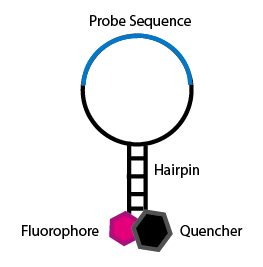
Molecular beacon
Encyclopedia
Oligonucleotide
An oligonucleotide is a short nucleic acid polymer, typically with fifty or fewer bases. Although they can be formed by bond cleavage of longer segments, they are now more commonly synthesized, in a sequence-specific manner, from individual nucleoside phosphoramidites...
hybridization probe
Hybridization probe
In molecular biology, a hybridization probe is a fragment of DNA or RNA of variable length , which is used in DNA or RNA samples to detect the presence of nucleotide sequences that are complementary to the sequence in the probe...
s that can report the presence of specific nucleic acid
Nucleic acid
Nucleic acids are biological molecules essential for life, and include DNA and RNA . Together with proteins, nucleic acids make up the most important macromolecules; each is found in abundance in all living things, where they function in encoding, transmitting and expressing genetic information...
s in homogenous solutions. The terms more often used is molecular beacon probes. Molecular beacons are hairpin
Hairpin
A hair pin or hairpin is a long device used to hold a person's hair in place.Hairpins made of metal, ivory, bronze, carved wood, etc. were used in ancient Assyria and Egypt for securing decorated hairstyles. Such hairpins suggest, as graves show, that many were luxury objects among the Egyptians...
shaped molecules with an internally quenched fluorophore
Fluorophore
A fluorophore, in analogy to a chromophore, is a component of a molecule which causes a molecule to be fluorescent. It is a functional group in a molecule which will absorb energy of a specific wavelength and re-emit energy at a different wavelength...
whose fluorescence
Fluorescence
Fluorescence is the emission of light by a substance that has absorbed light or other electromagnetic radiation of a different wavelength. It is a form of luminescence. In most cases, emitted light has a longer wavelength, and therefore lower energy, than the absorbed radiation...
is restored when they bind to a target nucleic acid sequence. This is a novel nonradioactive method for detecting specific sequences of nucleic acids. They are useful in situations where it is either not possible or desirable to isolate the probe-target hybrids from an excess of the hybridization probes.
Molecular beacon probes

A typical molecular beacon probe is 25 nucleotides long. The middle 15 nucleotides are complementary to the target DNA
DNA
Deoxyribonucleic acid is a nucleic acid that contains the genetic instructions used in the development and functioning of all known living organisms . The DNA segments that carry this genetic information are called genes, but other DNA sequences have structural purposes, or are involved in...
or RNA
RNA
Ribonucleic acid , or RNA, is one of the three major macromolecules that are essential for all known forms of life....
and do not base pair with one another, while the five nucleotides at each terminus are complementary to each other rather than to the target DNA. A typical molecular Beacon Structure can be divided in 4 parts:
- Loop: This is the 18–30 base pair region of the molecular beacon which is complementary to the target sequence.
- Stem: The beacon stem is formed by the attachment, to both termini of the loop, of two short (5 to 7 nucleotide residues) oligonucleotides that are complementary to each other.
- 5' fluorophore: At the 5' end of the molecular beacon, a fluorescent dye is covalently attached.
- 3' quencher (non fluorescent): The quencher dye is covalently attached to the 3' end of the molecular beacon. When the beacon is in closed loop shape, the quencher resides in proximity to the fluorophore, which results in quenching the fluorescent emission of the latter.
If the nucleic acid to be detected is complementary to the strand in the loop, the event of hybridization occurs. The duplex formed between the nucleic acid and the loop is more stable than that of the stem because the former duplex involves more base pairs. This causes the separation of the stem and hence of the fluorophore and the quencher. Once the fluorophore is distantiated from the quencher, illumination of the hybrid with light results in the fluorescent emission. The presence of the emission reports that the event of hybridization has occurred and hence the target nucleic acid sequence is present in the test sample.
Synthesis
Molecular beacons are syntheticOligonucleotide synthesis
Oligonucleotide synthesis is the chemical synthesis of relatively short fragments of nucleic acids with defined chemical structure . The technique is extremely useful in current laboratory practice because it provides a rapid and inexpensive access to custom-made oligonucleotides of the desired...
oligonucleotide
Oligonucleotide
An oligonucleotide is a short nucleic acid polymer, typically with fifty or fewer bases. Although they can be formed by bond cleavage of longer segments, they are now more commonly synthesized, in a sequence-specific manner, from individual nucleoside phosphoramidites...
s whose preparation is well documented. In addition to the conventional set of nucleoside phosphoramidites, the synthesis also requires a solid support derivatized with a quencher and a phosphoramidite building block designed for the attachment of a protected fluorescent dye.
Applications of molecular beacons
- SNP detection
- Real-time nucleic acid detection
- Real-time PCR quantification
- Allelic discrimination and identification
- Multiplex PCR assays
- Diagnostic clinical assays

